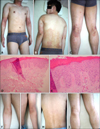Dear Editor:
A 32-year-old man presented with itchy erythematous to brownish skin lesions on the face, neck, trunk and the flexor surface of both extremities starting one year ago (Fig. 1A~C). He has had allergic rhinitis since childhood. With time, his symptoms got worse even with medications including oral steroid and cyclosporin. The initial clinical suspicion was atopic dermatitis (AD). Microscopic examination showed a chronic inflammatory lesion including focal hyperkeratosis, parakeratosis and irregularly acanthotic epidermis with spongiosis. Mild perivascular inflammatory cell infiltration and dilated vessels were in the dermis (Fig. 1D, E). The final diagnosis was AD. For his refractory AD, oral alitretinoin (30 mg/day) and topical steroid (betamethasone dipropionate) with calcipotriol monohydrate were prescribed. After four months of treatment, the skin lesions had subsided (Fig. 1F~I).
A 69-year-old woman presented with diffuse scaly erythematous skin lesions on the whole body surface (Fig. 2A~F). Her maternal grandfather and sister also had similar skin lesions. Until now, she had been treated with oral steroid and topical steroid intermittently but her scaly skin lesions got worse, especially during winter, over a span of 10 years. The initial clinical suspicion was exfoliative dermatitis after discontinuation of applied steroid. To confirm baseline skin disease such as psoriasis, punch biopsy was performed. Focal separated stratum corneum and parakeratosis, including neutrophils and red blood cells, were observed (Munro microabscess). Acanthotic epidermis without granular layer was observed. Inflammatory cells infiltrated the epidermis. Dilated vessels were in the dermis and psoriasis was confirmed (Fig. 2G, H). Due to her old age, hypertension, osteoporosis, history of gall stone and renal stone, prescription of oral cyclosporine or steroid didn't appear prudent. Oral alitretinoin was started in a dose of 30 mg daily and topical steroid (betamethasone dipropionate) with calcipotriol monohydrate was prescribed. Within five months of treatment, the skin lesions had improved without noticeable adverse effect (Fig. 2I~M). Informed consent was obtained from all patients about this report.
Alitretinoin (9-cis retinoic acid) is a novel antagonist vitamin A derivative, which binds both retinoic acid receptors and retinoid X receptors12. Alitretinoin has been found to produce an anti-inflammatory response2. In cases of AD, one study with six AD patients revealed that therapy with oral alitretinoin led to a substantial clinical improvement of both palmar lesions and extra-palmar manifestations of AD3. Anti-inflammatory and immunomodulatory effects and anti-proliferative and apoptotic effects could explain the mechanism of action also in AD. In vitro, alitretinoin inhibited production of nitric oxide and proinflammatory cytokines such as tumor necrosis factor (TNF)-α, interleukin (IL)-1β, and IL-12p4024. The efficacy of TNF-α inhibitors and the blocking IL-12/IL-23 antip40 monoclonal antibody ustekinumab against psoriasis was shown many times2. Therefore, the beneficial therapeutic effects of alitretinoin for psoriasis might possibly be due to suppression of TNF-α and IL-12/IL-23 cytokines1245. However, to employ alitretinoin for these indications, more studies including placebo controlled trials are warranted because there were no exact explanations about mechanism of treatment effect of alitretinoin on both chronic inflammatory skin diseases.
In conclusion, we report alitretinoin could be considered another choice for treatment of refractory AD or psoriasis.
Figures and Tables
Fig. 1
(A~C) A 32-year-old man presented with itchy erythematous to brownish skin lesions on the neck, trunk, and the flexor surface of both extremities. (D, E) Microscopic examination showed a chronic inflammatory lesion with focal hyperkeratosis and parakeratosis. Irregularly acanthotic epidermis with spongiosis was observed. Mild perivascular inflammatory cell infiltration and dilated vessels were in the dermis (H&E; D: ×100, E: ×200). (F~I) After four months of treatment with oral alitretinoin (30 mg/day) and topical steroid (betamethasone dipropionate) with calcipotriol monohydrate, the skin lesions subsided.

Fig. 2
(A~F) A 69-year-old woman presented with diffuse scaly erythematous skin lesions on her whole body surface. (G, H) Focal separated stratum corneum and parakeratosis, including neutrophils and red blood cells, were observed (Munro microabscess). Acanthotic epidermis without granular layer was observed. Inflammatory cells infiltrated the epidermis. Dilated vessels were in the dermis (H&E; G: ×100, H: ×200). (I~M) Within five months of treatment with oral alitretinoin (30 mg/day) and topical steroid (betamethasone dipropionate) with calcipotriol monohydrate, skin lesions had been improved without noticeable adverse effect.

ACKNOWLEDGMENT
This study was supported by grants of the National Research Foundation of Korea (NRF), funded by the Ministry of Science, ICT & Future Planning (NRF-2017R1A2B4006252), Korea Healthcare technology R&D project, funded by Ministry of Health & Welfare, Republic of Korea (HI17C0597), and the Hallym University Research Fund.
References
1. Irla N, Navarini AA, Yawalkar N. Alitretinoin abrogates innate inflammation in palmoplantar pustular psoriasis. Br J Dermatol. 2012; 167:1170–1174.

2. Meyer V, Goerge T, Luger TA, Beissert S. Successful treatment of palmoplantar hyperkeratotic psoriasis with a combination of etanercept and alitretinoin. J Clin Aesthet Dermatol. 2011; 4:45–46.
3. Grahovac M, Molin S, Prinz JC, Ruzicka T, Wollenberg A. Treatment of atopic eczema with oral alitretinoin. Br J Dermatol. 2010; 162:217–218.





 PDF
PDF ePub
ePub Citation
Citation Print
Print


 XML Download
XML Download